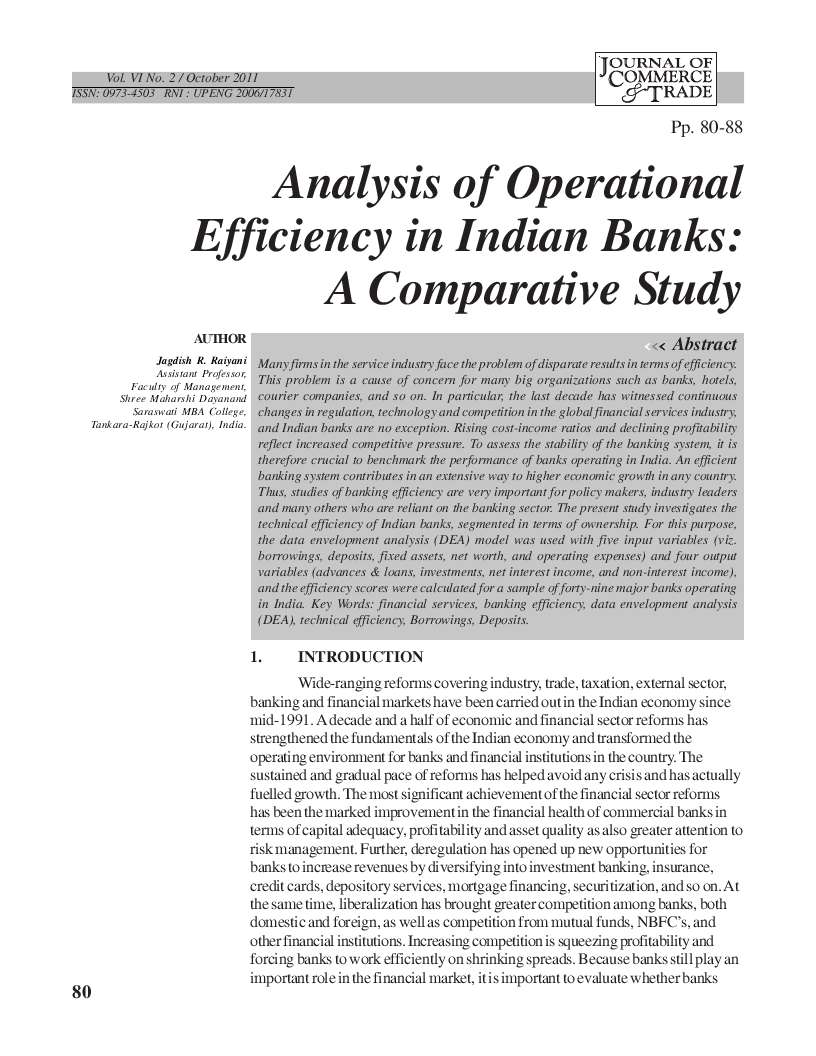Analysis of Operational Efficiency in Indian Banks: A Comparative Study
DOI:
https://doi.org/10.26703/jct.v6i2.338Keywords:
Financial Services, Banking Efficiency, Data Envelopment Analysis, DEA, Technical Efficiency, Borrowings, DepositsAbstract
Many firms in the service industry face the problem of disparate results in terms of efficiency. This problem is a cause of concern for many big organizations such as banks, hotels, courier companies, and so on. In particular, the last decade has witnessed continuous changes in regulation, technology and competition in the global financial services industry, and Indian banks are no exception. Rising cost-income ratios and declining profitability reflect increased competitive pressure. To assess the stability of the banking system, it is therefore crucial to benchmark the performance of banks operating in India. An efficient banking system contributes in an extensive way to higher economic growth in any country. Thus, studies of banking efficiency are very important for policy makers, industry leaders and many others who are reliant on the banking sector. The present study investigates the technical efficiency of Indian banks, segmented in terms of ownership. For this purpose, the data envelopment analysis (DEA) model was used with five input variables (viz. borrowings, deposits, fixed assets, net worth, and operating expenses) and four output variables (advances & loans, investments, net interest income, and non-interest income), and the efficiency scores were calculated for a sample of forty-nine major banks operating in India.
Downloads
References
Bhattacharyya, A., Lovell, C.A.K., and Sahay, P. (1997), “The Impact of Liberalization on the Productive Efficiency of Indian Commercial Banks”, European Journal of Operations Research, Vol.98.
Berger, A.N., Hassan, I., and Zhou, M. (2005), “Ownership, Financial Liberalization, and Efficiency of Chinese Banks,” FMA Working Paper Series 2005
Buch, C.M. (1997), “Opening up for Foreign Banks: How Central and Eastern Europe Can Benefit,” Economics of Transition, 5
Chatterjee, G. (1997), “Scale Economies in Banking: Indian Experience in Deregulated Era”, RBI Occasional Papers, Vol. 18, No. 1.
Claessens, S. and Glaessner, T. (1998), “The Internationalization of Financial Services in Asia,” Working Papers - Domestic finance, saving, financial systems, stock markets. 1911, World Bank
Claessens, S., Demirguc-Kunt, A., and Huizinga, H. (2001), “How does foreign entry affect the domestic banking market?” Journal of Banking and Finance, 25.
Das, A., Nag, A., and Ray, S.C. (2004), “Liberalization, Ownership, and Efficiency in Indian Banking: A Nonparametric Approach,” Economics Working Papers, University of Connecticut
Gilbert, R.A. and Wilson, P.W. (1998), “Effects of Deregulation on the Productivity of Korean Banks,” Journal of Economics and Business, 50.
Haslem, J. A., Scheraga, C.A. and Bedingfield, J.P. (1999), “DEA efficiency profiles of U.S. banks operating internationally,” International Review of Economics & Finance, Vol. 8, Issue 2
Isik, I. and Hassan, M. K. (2003), “Financial Deregulation and Total Factor Productivity Change: An Empirical Study of Turkish Commercial Banks,” Journal of Banking & Finance, 27(8).

Downloads
Published
Issue
Section
License
Copyright (c) 2011 Jagdish R. Raiyani

This work is licensed under a Creative Commons Attribution 4.0 International License.










